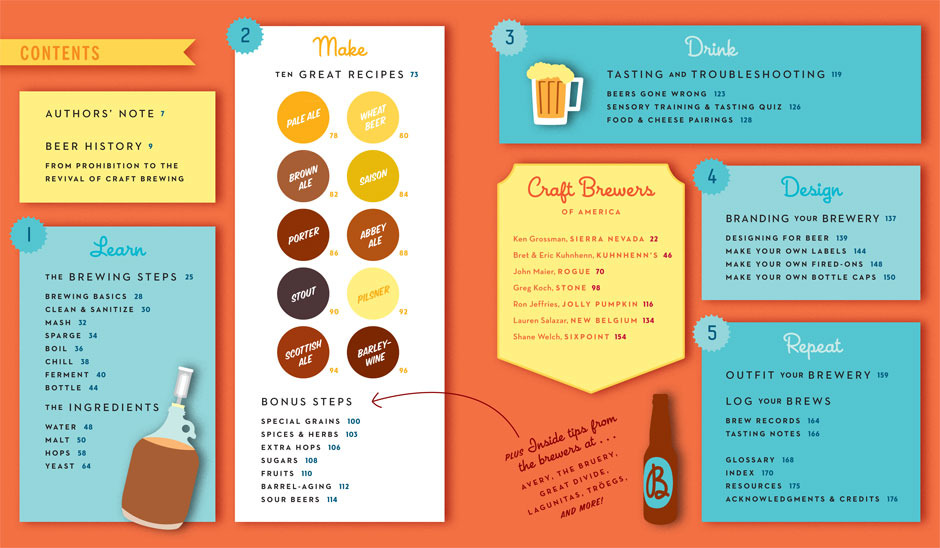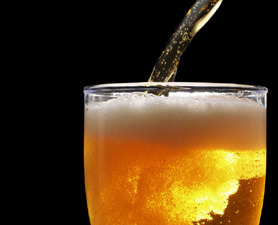If you are interested, or even just mildly curious, about how to brew beer at home, you need to read this book. This book excels over many other revered texts on home brewing simply for how straight forward and beautifully presented the informations is.
Brewing beer is not easy but it isn’t difficult either. It is an involved process with a lot of independent variables that the brewer is in control of. Because of this, every other book on brewing is typically a lengthy read. Beer Craft, on the other hand, is neither too wordy or too simple. It can easily be read in one sitting. Despite this, Beer Craft is just as informational as other books on home brewing. It is very clear what steps need to be followed exactly, and what steps you have the freedom to explore on your own. In addition to this, there are plenty of charts breaking down different ingredients and how they can be used. Brewing beer is a science. The ratios of the ingredients used and even the different temperatures used can alter the end product. Beer Craft does an excellent job of teaching the science without being too overwhelming.

Most books will recommend beginners start by using malt extract to brew beer. Beer Craft doesn’t even suggest this as an option, giving only all grain brewing methods. Where others will caution against the involvement required to brew all grain, Beer Craft provides the reader with one gallon recipes that can be brewed on a standard kitchen stovetop with supplies that do not require a hefty financial expense. This allows beginners to brew beer like the pros do, right from the get go.

Lastly, few books properly instruct beginners how to begin formulating their own recipes. Descriptions of beer styles is usually done by describing the final product, not the ingredients used to create it. Within Beer Craft are various charts showing what malts are used, and to what percent of the total grain bill, for each style of beer. Within each recipe Beer Craft gives, there are suggestions on what to change or add to the recipe. For example, Beer Craft provides a recipe for a pale ale. It then gives substitution suggestions to change it into an IPA, imperial IPA or even a black IPA. In addition to the recipe suggestions, one of the most useful chapters is one on adding specialty ingredients. Not only does it suggest different fruits or spices to add, but how much should be added and at what point in the process it should be added. Taken together, you learn what ingredients make up 10 different styles of beer, and suggestions on what to change in order to create other styles, or what to add to create something entirely new. If you want to brew an IPA with oranges, you can create a recipe simply by using the pale ale recipe, following the guidance on how to make it an IPA, then following the suggestions for adding citrus fruits. No other book I’ve read has shown me how to do this so easily.
I’ve learned more about beer reading this book than I have from reading anything else. This was also the shortest of all the beer books I’ve read and the best looking!
For more information, and more photos of the pages, go to the Beer Craft Book website
Imperial stout is a stout beer that is known for it’s higher alcohol content. Most stouts have about a 5% alcohol content. Imperial stout is around 10%. The name comes from the fact that the beer was made in England specifically for the imperial courts in Russia. The higher alcohol content was necessary to ensure that the beer would not freeze en route to it’s icy location.
Last night at the bar it was mentioned that many people don’t realize how many different types of beer there are. I thought I’d give a brief overview:
To simplify things, there are primarily two different types of beer: Ales and Lagers. At the most basic level, the difference between the two is the type of yeast used to ferment the beer. Lager yeast ferments at colder temperatures and ale yeast ferments at higher temperatures. Lagers and ales break down even further into different types of beers.
Lager:
This is the most prominent type of beer simply because this is the kind of beer that Budweiser, Miller and Coors are. Other common lagers are the popular Mexican beers: Corona, Dos Equis, Pacifico etc. These beers are best served at ice cold temperature and as such have a lighter more “refreshing” taste. Or as I think of it, kind of watered down taste. The predominant lager beers are American lagers and pilsners. Again simply because this is what the big 3 companies make. The good lagers are the kind that Germany makes: marzen, bock and dunkel. These beers are typically darker colored and have a much more complex taste than the common American lager. However these beers are still lighter in flavor and feel than most ales and don’t have a predominant hop taste.
Ales:
These are the more complex beers with a wider range of style. These range from the wheaty Hefeweizen and white beers (like Pyramid Hefeweizen or Blue Moon) to the dark stouts (like Guinness). Pale ales and India pale ales sit in the middle of the spectrum. IPAs and pale ales are recognized by their hoppy bite. Ales are the predominant type of beer everywhere except North America. I couldn’t begin to try and explain every type of ale because there is just so many kinds!
Ales are by far, my favorite kind of beer just because there are so many different kinds. The few beers that ive blogged about here have all been ales. I’ll try to continue to review different beers and use that opportunity to describe the beer type and it’s common characteristics.
The term “big beer” typically refers to beers that have a higher gravity, or alcohol content, than most other beers. I will soon be reviewing Dogfish Head’s “World Wide Stout” and I thought I’d take the time to explain what it is that makes these beers so unique.
For reference, most beer ranges from 4-6% alcohol. Usually, the higher stuff, IPA’s and Belgian ales, will range from 7-12% alcohol. The big beers will range from 12-20% alcohol. Any higher is practically impossible using traditional methods. World Wide Stout is 18% alcohol.
Below is a very brief overview of how beer is made:
– Malted barley is boiled in water. This releases, among other things, sugar into the water creating what is called “wort.”
– Because of the sweetness of the wort, hops are added to tone down the sweetness and add some bitterness and flavor. Hops are responsible for the “bite” that some beers have.
– Finally, the most important ingredient, yeast. Yeast determines whether a beer is a lager or an ale and, for purposes of this discussion, how much alcohol is in a beer.
Yeast is a living organism and, much like you and I, consume and create waste. The waste that yeast expels however, unlike you and I, is actually useful. Yeast consumes the sugar in the wort and expels CO2 and ethanol (alcohol) in it’s place. Thus, a carbonated, alcoholic drink! Once the yeast is added, it’s left to do it’s thing for about 2 weeks on average.
So how do you increase the alcohol content of a beer? The obvious answer is add more sugar and yeast. So, more malts = more sugar + more hops to balance out the sugars + more yeast to eat up all the sugar = more alcohol!
So how much more malts and hops are needed for the big beers? Dogfish Head’s 120 Minute IPA has the highest alcohol content of any other IPA at 18%. Dogfish has explained that for them to brew 120 Minute, they need “over 7 times the volume of malt and over 30 times the volume of hops than your average light lager.” Not only that, it is also “aged over 5 times longer than the average ale.”
To make these beers, it’s not just as simple as adding more ingredients either. It’s also very difficult to do so as well. Remember, ethanol is a waste product of yeast. Much like how neither you or I could live in a house of our own waste, ethanol is toxic to yeast. Meaning in high alcohol environments, yeast dies off rather than eating more sugar and creating more alcohol. This is why creating a beer thats over 20% alcohol is nearly impossible using traditional methods. There has to be a balance between the sugar, yeast, and alcohol.
More ingredients, higher difficulty level and longer time to complete the fermentation period mean that these are very expensive beers to make. For Dogfish Head to produce 120 Minute IPA it costs them half a million dollars! It is likely the same cost for their other big beers. For the single 12 oz bottle of World Wide Stout, Ho Foods (Whole Foods) charged me $10. Compare that to the usual $10-12 it’s costs for any other micro-brewed six pack.
That is why the big beers are so rare, expensive and unique. Few breweries can afford to take the risk of producing something of this caliber. Last year, Dogfish Head had to dump their productions of 2 of their big beers due to the lack of continued fermentation. This cost the company almost a million dollars in lost profits.
I’ve never personally tried any of Dogfish Heads big beers so I am very excited to try out the World Wide Stout that I purchased!
I read several articles today relating alcohol to health:
http://goo.gl/xcdp – Beer contains nutrients that make bones stronger and it is suggested that moderate drinking will reduce the risk of osteoporosis and other diseases
http://goo.gl/WbWe7 – Red wine prevents cavities.
The above articles are related to the chemistry of alcohol. The below articles are a bit more vague:
http://goo.gl/pbUFq – People who drink more, are more likely to exercise longer and more intensely.
http://goo.gl/2I7T9 – Women were monitored for 13 years. The non drinkers gained the most weight, the moderate drinkers gained the least weight
These articles, on their own don’t offer much of an answer. But then there’s this article:
http://goo.gl/LAQh – People with higher intelligence drink more than those with a lower intelligence.
I think that because those that drink typically have a higher intelligence, they are also more likely to have the knowledge to want to keep themselves healthy and in shape. But then the real question is, why is there a correlation between intelligence and alcohol consumption?
“An intelligent man is sometimes forced to be drunk to spend time with fools.”
—Ernest Hemingway
Or, it could just be that those with intelligence have a taste for the finer things in life, like a glass of red wine or a pint of craft beer!




